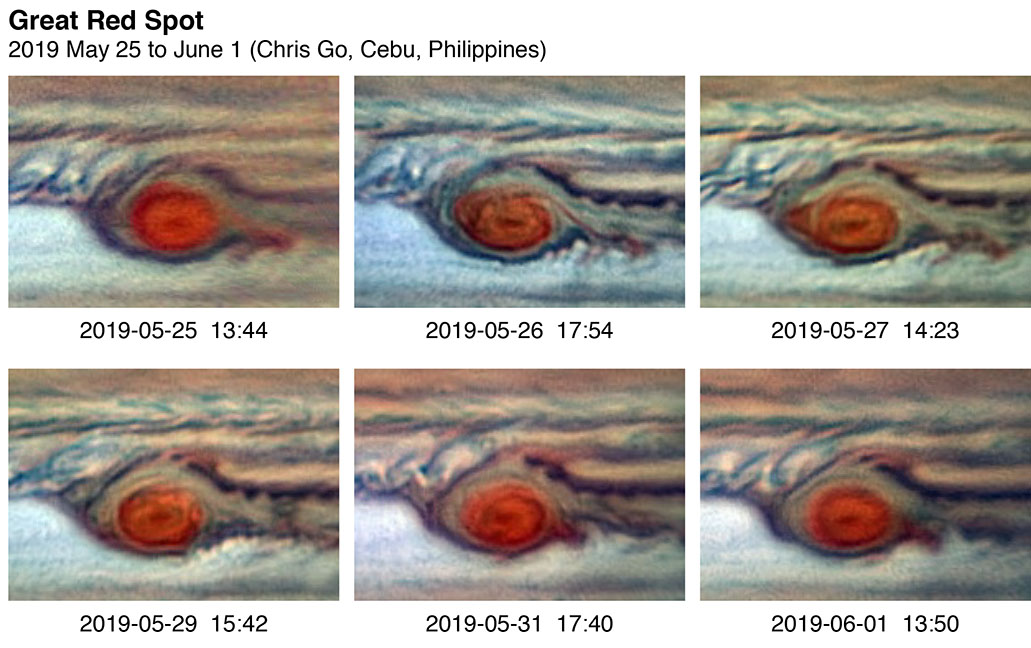Jupiter's Great Red Spot Storm Isn't Dying Anytime Soon

Despite the apparent shrinkage of clouds in Jupiter's Great Red Spot, the storm itself is still going strong, new research suggests.
Jupiter's Great Red Spot represents the most powerful storm in the solar system. While earlier studies have suggested that the storm has been shrinking since at least the 1800s, researchers from the University of California, Berkeley, argued today (Nov. 25) at a conference of the American Physical Society's Division of Fluid Dynamics that there is no evidence that the vortex that powers the cloud formation is changing.
"I don't think its fortunes were ever bad," Philip Marcus, a professor of fluid dynamics at the University of California, Berkeley, said in a statement released by the society. "It's more like Mark Twain's comment: The reports about [the storm's] death have been greatly exaggerated."
Related: Jupiter's Great Red Spot in Photos
The Great Red Spot has been photographed by both professional and amateur astronomers. Photos captured in May and June 2019 revealed large red "flakes" spinning off from the storm, which fueled assumptions that the system is getting smaller.
However, observers don't see the storm directly, only the visible clouds above it, Marcus said. He and his colleagues suggest that the "flaking" observed around the storm is a natural consequence of storms interacting, rather than an indication that the Great Red Spot storm is itself weakening.
As a smaller storm spinning the opposite direction approaches the Great Red Spot, a point of stagnation form. Then, when a smaller storm spinning the same direction as the monster storm approaches, its clouds are shattered and flake away in a reddish extension like that observed on the east side of the storm this spring, said Marcus, whose research focuses on the fluid dynamics of vortices, waves, turbulence and hydrodynamic stability.
Get the Space.com Newsletter
Breaking space news, the latest updates on rocket launches, skywatching events and more!
"These are very normal healthy activities for the Red Spot and its colleagues," Marcus said during a news conference held at the society's meeting.
In addition, Marcus said, he expects that the heating and cooling patterns around the vortex will continue to fuel the Great Red Spot.
"I think that unless something somewhat cataclysmic happens on Jupiter, it will last for the indefinite future, until the jet streams change, so I would say likely centuries," Marcus said in the news conference. "Of course, I probably just gave it the kiss of death and it'll probably fall apart next week, but that's the way science works."
- Photos: Jupiter, the Solar System's Largest Planet
- In Photos: Juno's Amazing Views of Jupiter
- Jupiter's Great Red Spot: A Monster Storm in Pictures
Follow Samantha Mathewson @Sam_Ashley13. Follow us on Twitter @Spacedotcom and on Facebook.

Join our Space Forums to keep talking space on the latest missions, night sky and more! And if you have a news tip, correction or comment, let us know at: community@space.com.

Samantha Mathewson joined Space.com as an intern in the summer of 2016. She received a B.A. in Journalism and Environmental Science at the University of New Haven, in Connecticut. Previously, her work has been published in Nature World News. When not writing or reading about science, Samantha enjoys traveling to new places and taking photos! You can follow her on Twitter @Sam_Ashley13.
-
rod I was glad to read this report on the Great Red Spot (GRS) - likely continuing for sometime for telescope users to enjoy :) Viewing Jupiter at 150x or more and seeing the GRS rotate into your eyepiece field of view, especially while watching a Galilean moon transit - is very cool. It does not take long for the GRS to move towards the central meridian, about 2 hours or a bit and there goes the GRS moving across the field of view :) Same for those Galilean moons too.Reply









